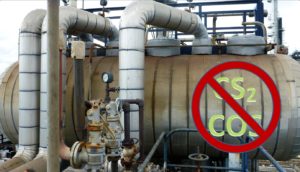 Sulfur recovery loss can be significant if the Carbon Disulfide (CS2) and Carbonyl Sulfide (COS) are not hydrolyzed. Since Claus reaction only involves H2S and SO2, any other sulfur-bearing compound will not participate in the Claus reaction. They will just hover through the process, eventually burning in the incinerator to be added to the plant’s emission. CS2 is worse than COS because it has two atoms of sulfur. The amount of CS2 and COS formation in the reaction furnace depends on the amount of hydrocarbon and carbon dioxide in the feed. COS formation appears to be related to the amount of CO/CO2 in the feed while CS2 is associated with the amount of hydrocarbon.
Sulfur recovery loss can be significant if the Carbon Disulfide (CS2) and Carbonyl Sulfide (COS) are not hydrolyzed. Since Claus reaction only involves H2S and SO2, any other sulfur-bearing compound will not participate in the Claus reaction. They will just hover through the process, eventually burning in the incinerator to be added to the plant’s emission. CS2 is worse than COS because it has two atoms of sulfur. The amount of CS2 and COS formation in the reaction furnace depends on the amount of hydrocarbon and carbon dioxide in the feed. COS formation appears to be related to the amount of CO/CO2 in the feed while CS2 is associated with the amount of hydrocarbon.
Even though COS and CS2 formations are undesirable, these compounds will inevitably form because acid gas feed always contains hydrocarbon and CO2 due to process limitations in the amine unit and sour water stripper. The best way to resolve this issue is to hydrolyze COS and CS2 back to H2S. Studies show that higher bed temperatures in the first converter promote hydrolyzation; however, conversion efficiency is favored by lower temperature.
So, the first catalytic reactor’s (1st converter) main goal is to hydrolyze COS and CS2 back to H2S. For an active alumina catalyst, bed temperatures between 630oF to 650oF (332oC to 3430C) are adequate to achieve maximum hydrolysis. Specialty catalysts like the Titania catalyst can be run at a lower temperature to gain more conversion while maintaining a high hydrolysis rate. If the plant has a Shell Claus Off-gas Treating (SCOT) unit or other oxidizing/reducing type tail gas units, COS and CS2 hydrolysis can happen in the tail gas reactor and will be recovered and recycled as H2S.
It is also important to know if the catalyst beds are fully active. Deactivated catalysts reduce the hydrolysis rate of COS and CS2. The first bed is more vulnerable to deactivation since it is the first bed to be exposed to contaminants if they were not destroyed in the reaction furnace (e.g., Benzene, Toluene, Xylenes). And since the second and third beds are operated just above the process gas dew point temperature, hydrolysis of COS and CS2 is insignificant.
For more information on sulfur recovery loss and SRUs, come visit us as RefComm® Galveston 2018 where Noel will be leading exciting classes on sulfur recovery loss and much more. Be sure to visit the SulfurUnit.com website and follow us on the SulfurUnit Facebook page to get the latest breaking news on SRUs.
One response to “Sulfur Recovery Loss Due to COS/CS2 Formation”
Leave a Reply
You must be logged in to post a comment.







[…] Sulfur Recovery Loss Due to COS/CS2 Formation […]